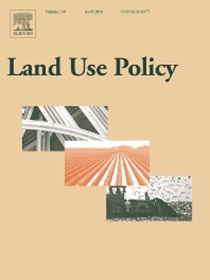The role of urban greening in limiting land take in case of population growth: Evidence for Europe 2005–2018
IF 5.9
1区 社会学
Q1 ENVIRONMENTAL STUDIES
引用次数: 0
Abstract
Built-up land is supposed to serve the population. The question is how changes in population affect changes in land use. In the case of population growth, one can expect a densification of settlements that does not involve land take or spatial spillovers that convert land into built-up areas (urbanisation). In the case of population decline, land may remain as built-up land or be returned to other uses (greening). This paper examines these patterns for Europe for the years 2005–2018, based on LUCAS data for land use and census data for population. It is a low granularity analysis on a 2 km x 2 km grid with more than 1 million grid cells. It uses unsupervised learning methods - market basket analysis to detect major trends, and econometric probit models to find factors that determine the probability of land use transitions. We find that there is no strong population pressure. Even if the European territory undergoes all possible patterns of change, in general the built-up area remains as it was or disappears even under population growth. The explanation for this phenomenon lies in urban greening and sustainable development policies.
在人口增长的情况下,城市绿化在限制土地占用方面的作用:2005-2018年欧洲的证据
建设用地应该是为人口服务的。问题是人口的变化如何影响土地利用的变化。在人口增长的情况下,可以预期定居点的密集化,但不涉及土地占用或将土地转化为建成区的空间溢出(城市化)。在人口减少的情况下,土地可以保留为建筑用地或被恢复为其他用途(绿化)。本文基于LUCAS土地使用数据和人口普查数据,研究了2005-2018年欧洲的这些模式。它是对2 km x 2 km网格的低粒度分析,网格单元数超过100万个。它使用无监督学习方法——市场篮子分析来检测主要趋势,使用计量经济学probit模型来找到决定土地利用转变概率的因素。我们发现没有很大的人口压力。即使欧洲领土经历了所有可能的变化模式,总的来说,建成区仍然保持原样,甚至在人口增长的情况下消失。对这一现象的解释在于城市绿化和可持续发展政策。
本文章由计算机程序翻译,如有差异,请以英文原文为准。
求助全文
约1分钟内获得全文
求助全文
来源期刊

Land Use Policy
ENVIRONMENTAL STUDIES-
CiteScore
13.70
自引率
8.50%
发文量
553
期刊介绍:
Land Use Policy is an international and interdisciplinary journal concerned with the social, economic, political, legal, physical and planning aspects of urban and rural land use.
Land Use Policy examines issues in geography, agriculture, forestry, irrigation, environmental conservation, housing, urban development and transport in both developed and developing countries through major refereed articles and shorter viewpoint pieces.
 求助内容:
求助内容: 应助结果提醒方式:
应助结果提醒方式:


